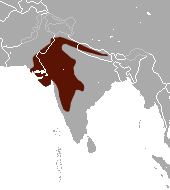Anderson's shrew
From Wikipedia, the free encyclopedia
| Anderson's Shrew | |
|---|---|
| Conservation status | |
| Scientific classification | |
| Kingdom: | Animalia |
| Phylum: | Chordata |
| Class: | Mammalia |
| Order: | Soricomorpha |
| Family: | Soricidae |
| Genus: | Suncus |
| Species: | S. stoliczkanus |
| Binomial name | |
| Suncus stoliczkanus | |
 | |
| Anderson's Shrew range | |
The Anderson's Shrew (Suncus stoliczkanus) is a medium-sized species of shrew. It is light gray in color with yellow fur around the throat and pectoral region, comparatively large ears and a tail that measures about 50 - 70% of body length. This shrew species is widespread, found in Bangladesh, India, Nepal, and Pakistan, in gardens and grassy embankments near watercourses (Sindh and Punjab regions, India), under piles of brushwood in forest plantations (Punjab) as well as the bases of stone walls in Kathiawar (Roberts, 1977), and also in desert and arid country (Hutterer, 1993). As far as is known, the habits of the Anderson's Shrew are largely nocturnal and solitary. Breeding may extend throughout the year.
References
- Insectivore Specialist Group 1996. Suncus stoliczkanus. 2006 IUCN Red List of Threatened Species. Downloaded on 30 July 2007.
- Stone, David. Suncus stoliczkanus, Eurasian Insectivores and Treeshrews, 1995.. 2009 IUCN Red List of Threatened Species.
This article is issued from Wikipedia. The text is available under the Creative Commons Attribution/Share Alike; additional terms may apply for the media files.
